Key takeaways:
- The Vintage Car Expo creates a sense of community among classic car enthusiasts, fostering friendships and shared stories.
- Classic car restoration preserves history and evokes strong emotional connections, transforming old vehicles into treasures.
- Having the right tools and an organized approach significantly enhances the restoration process, making it more efficient and enjoyable.
- Patience, embracing challenges, and utilizing community support are vital lessons learned throughout restoration projects.
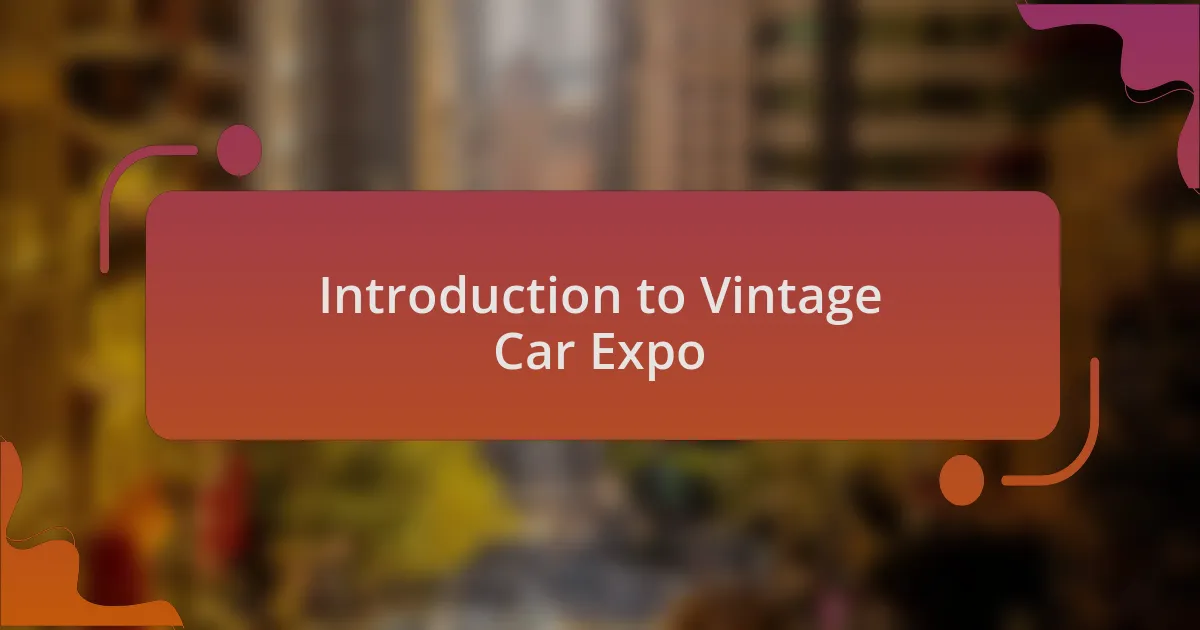
Introduction to Vintage Car Expo
The Vintage Car Expo is a vibrant celebration of automotive history, where enthusiasts and collectors come together to share their passion for classic cars. I still remember my first time attending this event; the moment I stepped inside, the smell of polished metal and vintage leather immediately transported me to a different era. Have you ever felt the joy of seeing a beautifully restored vehicle that tells a story all its own?
Every year, the expo showcases an impressive array of vintage cars, from elegant sedans to powerful muscle cars, each presenting a unique glimpse into the past. I often find myself chatting with other attendees about their favorite models, and it’s fascinating how many personal stories emerge. Isn’t it incredible how a car can evoke such strong memories or dreams of the open road?
What truly sets the Vintage Car Expo apart is the sense of community that envelops you upon arrival. It’s more than just a display of vehicles; it’s a gathering where friendships form over shared interests. Personally, I’ve forged lasting connections with fellow car lovers, proving that our shared passion for these classics can bridge any gap. Who else finds that these connections are often one of the most rewarding aspects of being a vintage car enthusiast?
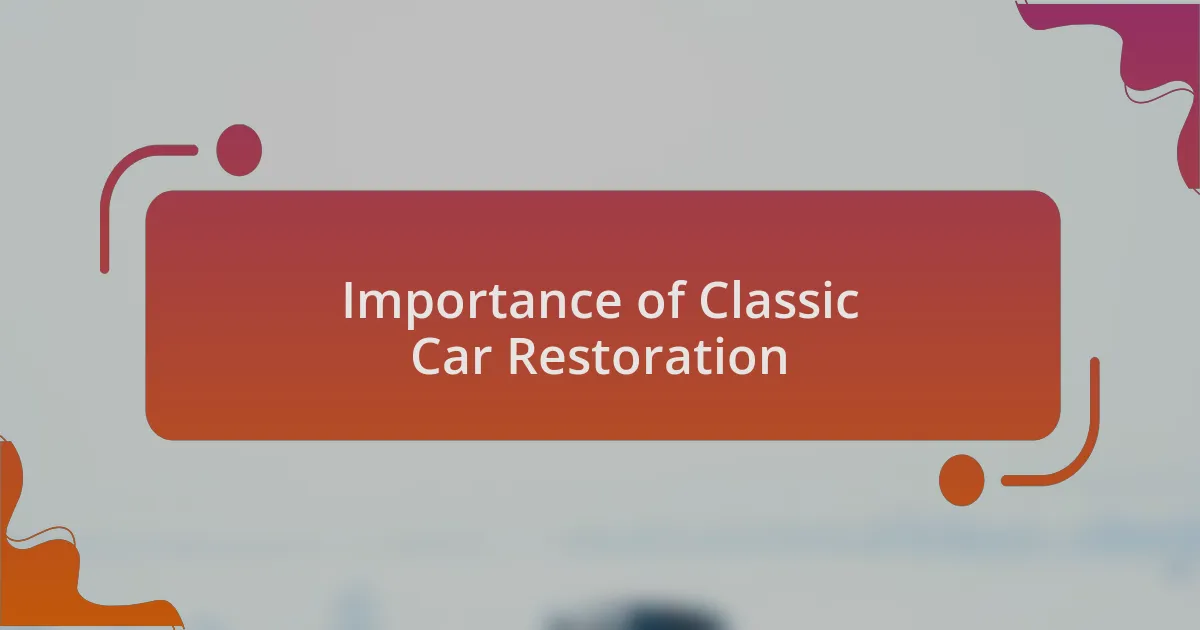
Importance of Classic Car Restoration
Restoring a classic car is about much more than just aesthetics; it’s about preserving a piece of history. I remember my first restoration project, a beloved old Chevy. Each dent and scratch told a story, and as I carefully brought it back to life, I felt a connection to the generations that cruised in it before me. Have you ever considered how restoring a classic can keep the spirit of the past alive for future generations?
The process of restoration can also foster a profound sense of achievement. When I finally saw my restored car gleaming in the sunlight, the feeling was indescribable. It reminded me that every challenge faced during the journey—whether it was sourcing parts or learning new skills—was worth it. Don’t you find that there’s something deeply satisfying about taking something that some might consider a relic and turning it into a treasure?
Moreover, classic car restoration helps to build a community of like-minded individuals who share a passion for automotive heritage. I’ve often leaned on fellow enthusiasts for advice during my projects, creating bonds over the intricacies of engine work or paint matching. This connection is vital; it transforms solitary efforts into shared experiences. Isn’t it amazing how a common interest in vintage cars can cultivate friendships that last a lifetime?
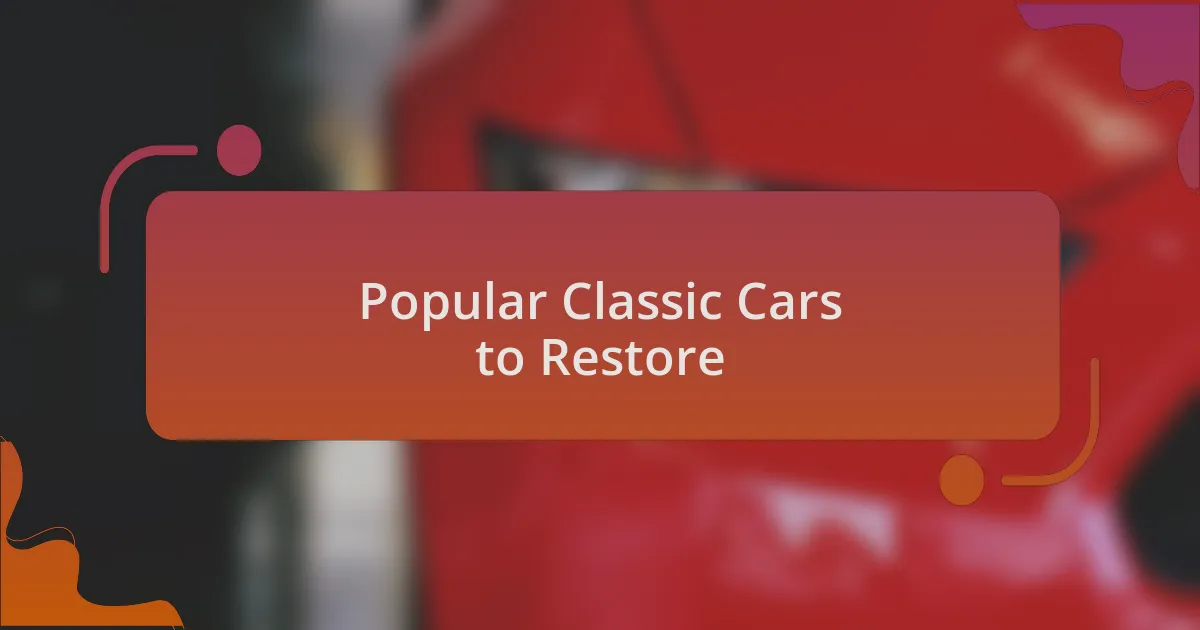
Popular Classic Cars to Restore
The Ford Mustang is one of the most iconic classic cars to restore. I remember the first time I laid eyes on a vintage ’67 model; its curves and power captivated me immediately. When talking to owners, they often share that restoring a Mustang isn’t just a project; it’s an emotional journey filled with memories of racing down summer roads. What do you think it is about Mustangs that draws so many enthusiasts to them?
Another popular choice is the Chevrolet Camaro, especially the late ’60s models. I once helped a friend restore his ’68 Camaro, and it was fascinating to see how the project unfolded. From the rumble of the engine to the classic interior details, each step in the process felt monumental. Don’t you find it incredible how a project like this can transform a rust bucket into a classic muscle car ready to hit the streets again?
The Volkswagen Beetle is also a gem when it comes to restoration. With its unique design and history, taking on a Beetle project can feel like you’re preserving a bit of quirky automotive culture. I still recall the joy I felt when we finally got the engine running smoothly after countless hours of tinkering—it felt like we revived a piece of nostalgia together. What classic car holds a special memory for you?

Essential Tools for Restoration
When it comes to restoring classic cars, having the right tools can make all the difference. I still remember the first time I held a quality set of wrenches—they felt like an extension of my own hands. It’s incredible how the right tools can not only streamline the process but also enhance the joy of turning rust into something beautiful. What tools have you found essential in your projects?
Another must-have in any restoration kit is a reliable jack and stands. During my last restoration, I was amazed at how much easier it was to work on the undercarriage of a car when I had the right equipment. I used to struggle with jacking cars up with flimsy tools, but a sturdy jack changes everything. Have you ever experienced a project where the right setup transformed your work?
Don’t underestimate the importance of specialized tools, like a torque wrench or an impact driver. These not only ensure that components are secured perfectly but also save time and reduce frustration. I recall using an impact driver on a stubborn bolt that would have taken hours to remove otherwise—it felt like a small victory. Which tool do you think has had the most significant impact on your restoration experiences?
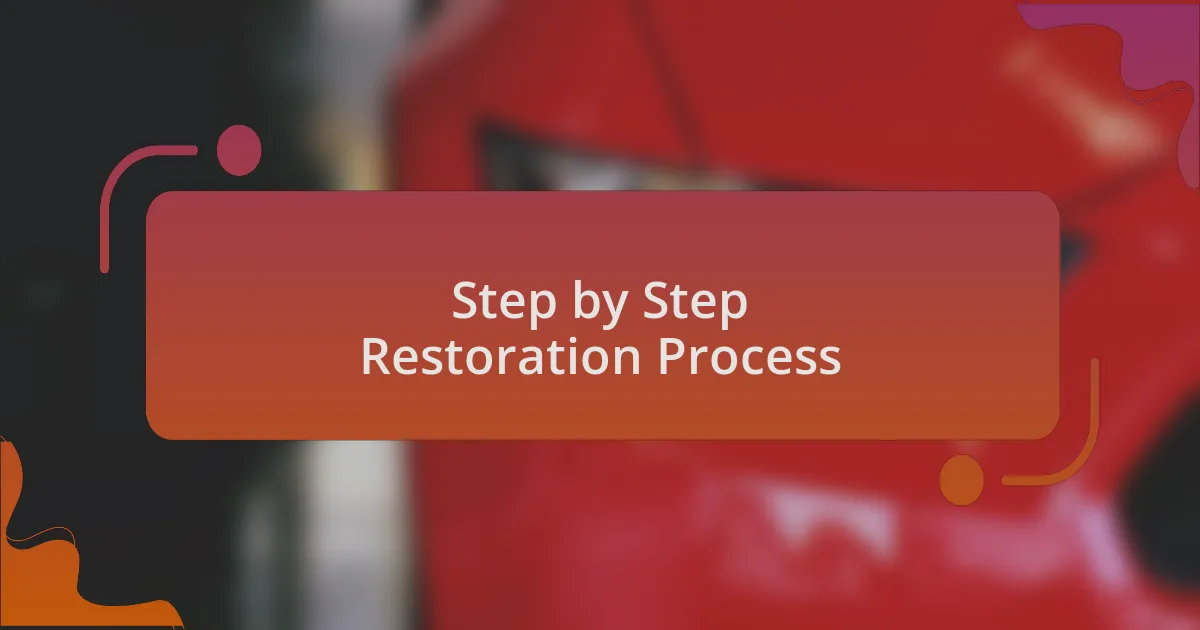
Step by Step Restoration Process
The first step in my restoration process usually begins with a thorough assessment of the car. A well-formed plan can save countless hours down the line. I remember feeling both excitement and dread when I discovered hidden rust in an old Mustang; it was a moment that taught me the value of a comprehensive evaluation before diving into repairs. How do you approach the initial assessment?
Once I’ve mapped out what needs fixing, I dive into dismantling the car systematically. I take photos at each step and label parts, creating a small archive for reference. This habit of documentation has saved me from confusion more times than I can count—while tackling a vintage Volkswagen, I found that my organized approach made reassembly feel more like putting together a puzzle rather than solving a mystery. Have you found organization to be as crucial in your process?
The surprises during the restoration process can be both delightful and daunting. After stripping the body down to bare metal, I remember feeling a mix of triumph and anxiety about potential hidden issues. It’s in these moments that resilience comes into play; tackling each challenge, like replacing rotted wood in a classic truck, not only pushes my skills but also deepens my connection to the vehicle. How do you handle unexpected challenges in your projects?
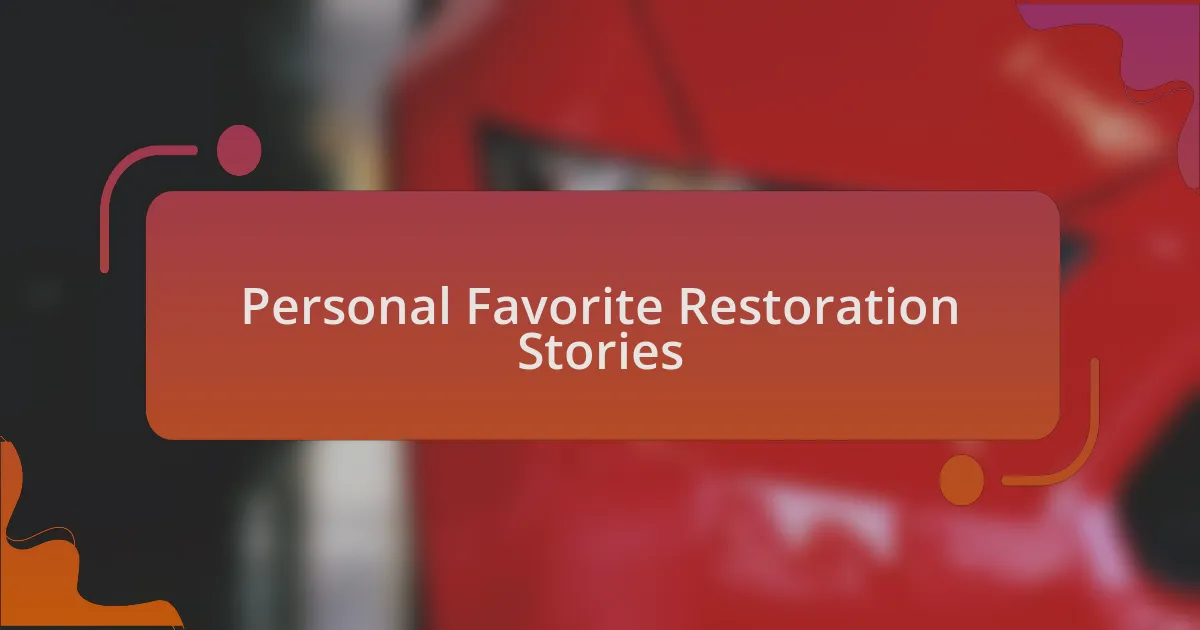
Personal Favorite Restoration Stories
One of my all-time favorite restoration stories involves a 1967 Chevrolet Camaro that I stumbled upon at a local estate sale. The car had been neglected for decades and was covered in dust, but as I brushed it off, a spark of nostalgia ignited within me. I could almost hear its engine roaring to life again. Have you ever felt that rush when you discover a hidden gem?
During the restoration, I faced a heart-wrenching moment when I discovered that the original engine was beyond saving. I had to make the tough decision to replace it, opting for a modern LS swap instead. Initially, I felt a bit guilty about straying from originality, but as I drove the car for the first time with its new heart, that anxiety transformed into sheer exhilaration. Have you wrestled with similar choices in your projects?
A personal highlight of another restoration was reupholstering the interior of a classic Mustang with new leather. I sank my hands into the soft material, recalling the stylish road trips of my youth. As I carefully sewed the final stitch, I couldn’t help but get choked up, knowing I was preserving not just a car, but a sense of history and memory. What aspects of your restorations evoke the strongest emotions for you?
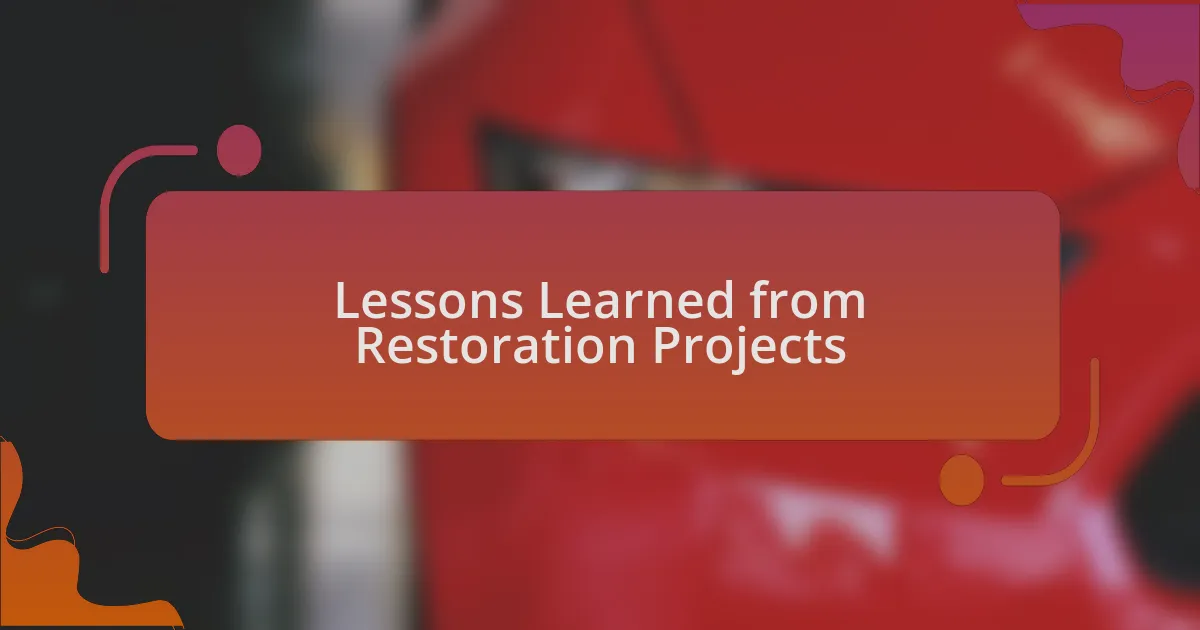
Lessons Learned from Restoration Projects
When diving into restoration projects, one valuable lesson I learned is the importance of patience. I recall a time when I was working on a vintage MG that appeared straightforward but turned into a labyrinth of surprises. Each step revealed issues I hadn’t anticipated, like rust in places I never thought to check. It taught me that rushing through the process often leads to regret, and taking my time ensures a more rewarding outcome. Have you ever felt the frustration of skipping over details only to come back and fix them later?
Another key insight is to embrace the learning curve. During a daunting frame-off restoration of a 1965 Mustang, I initially struggled with dismantling components and understanding their intricacies. However, as I immersed myself in the process, I found satisfaction not only in the work itself but also in gaining newfound skills. I still remember that moment of clarity when I finally understood how the drivetrain connected to the chassis. Have you had a moment when a challenge led to a breakthrough?
Finally, I can’t stress enough the importance of community in restoration projects. I vividly recall attending a local car meet where I shared my journey with fellow enthusiasts. Their tips on sourcing rare parts and their willingness to lend a hand made a world of difference. It was a stark reminder that we are not alone in this passion—there’s a wealth of support out there. Have you tapped into the collective knowledge of your car-loving community?